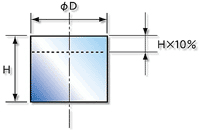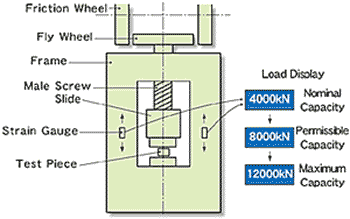Load Gauge Display and Selection for the Screw Press
1 Evaluation of Capacity Procedure (Nominal capacity)
Evaluation of the screw press capacity is made with testing a work piece in cold compression. Evaluation criterion comes from the ability that can crash more than 10% of the testing work piece calculated its dimension depending on the capability

Reference
"Compression of the metal, Load test procedure for stamping machine", JIS B 6402
Material : SS 400 in JIS G 3101 or equivalent or more of the material
Procedural Condition : Compress the equivalent amount of 10% height with the material that is calculated diameter and height from following formula depending on nominal capacity.
D=4√p / 10
where D ; Test piece diameter (mm), p; Nominal Capacity (kN).
Calculation example
The screw press of 4000kN; D = H = 4 √4000 /10 = 80 mm
The press can have capacity of 4000kN if it can compress equal or more than 8 mm (10%) height of the testing work piece configured with both 80 mm of diameter and height.
2 Capacity Test and Load Display Setting
Set up the press slide speed and the slide stroke as maximum (adjust to maximum power). In this status, compress the testing work piece and detect the frame deformation through strain gauge to show kN value on a load gauge.

setup example
The screw press of 4000kN; Set the load gauge that shows figures of 4000 when the testing work piece is compressed with the equivalent of 4000kN. In other word, as the compression value for the testing piece is criterion, set the figures of equivalent amount on the load gauge.
When you set up two strain gauges at each side of the frame, the load on one side frame (equals to a half of the load) becomes setting value and shown as certain kN in RH and LH independently, plus total kN in the display. Two independent load display for each side simply shows one sided load and the total load is defined as screw press load.
3 Maximum Load
(Maximum Capacity and Maximum Workload)
In case of the operation, hard-on-hard, in which striking die against die with the same condition as the above item ? (at maximum ram speed and maximum stroke), without pressing test piece, and a three time figure of normal value is displayed on the load gauge since the press energy (flywheel energy) for deforming test piece is spent only for stretching frame. (Frame is stretched by three times) This three time figure shows the maximum applied load of the press.
note
In screw press, the flywheel revolution energy is consumed one hundred percent in each press cycle. It is just a matter of revolution energy usage whether it is used for work piece compression or the frame deformation. During work process like vertical compression of heated bar material, the energy is consumed for plastic deformation of the material mostly and the frame bears very small amount of load shown low value on the load gauge. On the contrary, cold working stamping or stamping of steel plate with many edge burrs indicates large figures on the load gauge even if energy adjustment is relatively small. Normally, compression between upper and lower tools gives approximately nominal capacity load to the frame indicated on the load gauge when the energy adjustment is made around by 20%.
4 Permissible Load (Permissible Capacity)
Machine life is drastically shortened if the press is used under three more times of nominal capacity (maximum capacity) repeatedly (usually, the screw and the frame get damage). Because the press is designed to deform product, not for assuming of crashing tools themselves repeatedly. Here a problem occurs how much the allowable applied load of a press being set witch coming from rigidity design of machine. Taking 1.6 times of nominal capacity is preferred for energy significant type (processing like smash up) which requires much forming energy such as hot forging and taking two times of nominal capacity is preferred for much load on frame during cold forging (processing like bouncing back) such as coining. Even though frame is the same, larger amount of flywheel energy is put on to be a large performance press for hot forging and smaller amount of flywheel energy is put on to be a small performance press for cold forging. The allowable performance for the former is 1.6 times and for the latter is 2 times, those of which show different nominal capacity but the allowable performance is the same.
note
We are sometimes advised that we should design the machine that can’t get damage under maximum load. Surely, it is possible, however, can you imagine and would like to have the screw press that has the frame of 10000kN press with flywheel of 3000kN press and is used as nominal capacity of 3000kN press? It becomes quite expensive machine though we could manufacture it. Though it’s up to the material and the design, you could say that heavier machine weight and larger screw diameter has higher rigidity, larger tolerance and longer life if you would compare with same nominal capacity machines.
5 Overload Stop (Overload Protection)
There are always risks that the load surpasses the allowable load. Since the screw press has no mechanical lower-dead-point, the machine never stops caused from overload (stick) like the crank press machine. That means that there exists a risk that the machine is used under overload situation without knowing. Therefore, the press needs to have emergency stop mechanism if the overload happened. We are taking the method that the machine gives warning signal to operator through LED lamp when the machine is in overload emergency stop status from electric signal of the load gauge
note
We don't use the torque limiter approach attached to the flywheel discharging overload energy. It's hardly recognizable to the operator if the torque limiter functions under the overload condition. Our company does not employ this method because in case of hardened spring adjustment of the torque limiter by mistake, machine may always running with overload and finally machine may brake.
6 Relationship Between Forming Energy
and Load Gauge Display
Forming energy is completely same with flywheel energy. Also, these are proportional to slide descending speed, too. In the screw press, generally, the forming energy is adjusted with slide speed control just before stamping. Attention is required that there is no relationship or relativity between the forming energy and the load display. You may recognize from the above discussion that the load gauge display quite differs when smash up a test piece or strike die against die even if the forming energy is the same.
The load gauge simply displays the result of how many kN loaded to the frame. You can adjust the slide speed freely (adjustable forming energy freely), however, you can't control how many kN to strike. (Naturally, if you form product under the same condition, the slide speed adjustment is proportional to the load gauge display.)
note
The slide speed adjustment takes the method that controls to have same speed every cycle based on encoder signal detected the slide descending speed. The required speed is previously set on touch panel or by setting dial. If the preset value is small, the slide is clutched off right after acceleration and it descends evenly with inertia. Its control is where the point to clutch off, not revolution control like inverter motor.
The flywheel revolution is sequentially controlled in a servomotor direct driven system without clutch transmission. Acceleration and speed reduction are combined automatically to apply power with the Minimum time for one cycle
7 Caution for Selection of Screw Press Capacity
Considering of screw press’ frame allowable load is also important factor together with forming energy (such as “which kN press?”). That is, though the forming energy can still be increased, sometimes it can’t do anymore because the frame’s allowable load becomes unbearable. Especially, in those large edge burrs and cold working, it could become out of the allowable load even if the forming energy value is still a half of it. The capacity of screw press should be used with the nominal capacity. Using the allowable capacity is disputable from the point of fair business transaction. As explained earlier, the press can compress a test piece with nominal capacity, however, it is absolutely impossible to do with the allowable capacity.
8 Eccentric Load
Basically, eccentric load out of the screw diameter should be avoided. The load that can be allowable becomes reducing when it becomes far from the center. The load should be placed on the center fundamentally



















